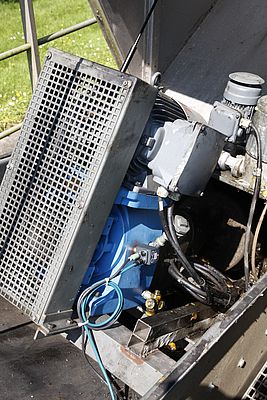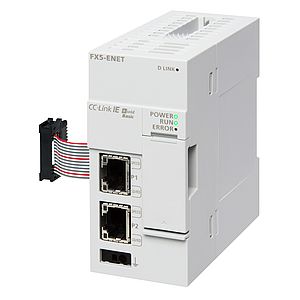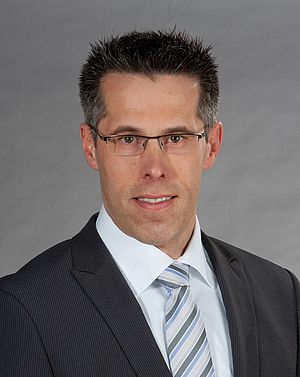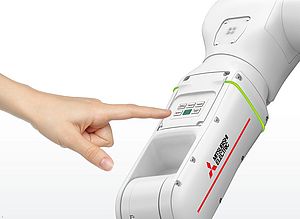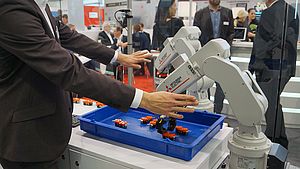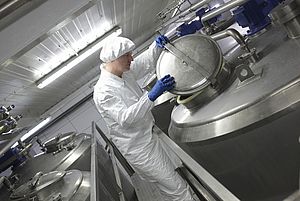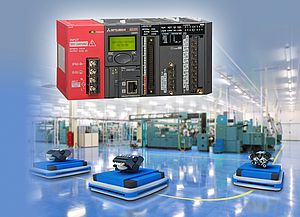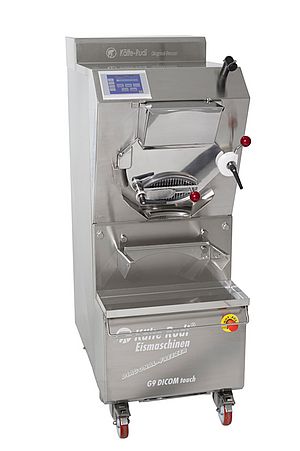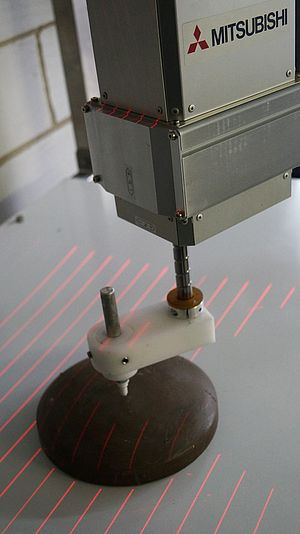Stadtwerke Rotenburg a. d. Fulda's sewage treatment plant is designed for a load of 34,000 population equivalent, and it actually caters for around 20,000 people at present. Three Archimedes pumps are connected to the secondary settlement basin at the sludge recirculation pumping station. They ensure that biological sludge from the secondary settlement basin does not flow into the Fulda, but back into the aeration basins, where the micro-organisms break down dissolved and fine particulate organic pollutants in the waste water. "The sludge from the biological treatment should under no circumstances enter the Fulda, because the micro-organisms would lead to environmental problems. We have to make sure that the pump drives in the sludge recirculation pumping station are always running perfectly. In an emergency, we can make do with submersible pumps to maintain the flow rate", explains Antonio Genovese, waste water treatment plant manager at the sewage works in Rotenburg.
Due to a design fault, each of the three pumps failed within a period of about a year. The maximum service life of a gearbox was about two and a half years. At the time the failure occurred, only mechanical damage could be found: because of bearing damage, the gear block was literally torn apart and had to be completely replaced - which was a costly affair.
Monitoring solution implemented quickly
Stadtwerke Rotenburg has been working with Willich since 1992. The system integrator relies on automation solutions by Mitsubishi Electric. This means that various generations of Mitsubishi Electric inverters, control systems and I/O modules, as well as operating units, can be found in Rotenburg. To solve the problems in the sludge recirculation pumping station, Willich and Mitsubishi Electric proposed to the Stadtwerke the condition monitoring solution with FAG SmartChecks, which they intended to test in use in the field as a reference project within this context. Michael Böttner, a programmer at Willich, describes the idea: "By monitoring with the vibration sensors we obtain information early regarding any deviations from normal values which could lead to damage to the machine. The exact cause can be determined depending on the type of deviation, and the problem can quickly be targeted and corrected. This means that a time and cost intensive total breakdown can be avoided, with a positive effect on operational safety and overall operating costs."
A few weeks passed from the original idea until monitoring was implemented: the system layout was defined in an on-site meeting, pre-wired and installed and commissioned within one day. The first pre-alarm came after nine months. After a further four months, the gearbox failed completely. Antonio Genovese explains: "The documentation to date makes clear how early the initial warning points to a deviation from normal - which can presumably be corrected easily - but can lead to total failure about three months later. With the assistance of condition monitoring, it is possible to target the fault and correct it.
Depending on the severity of the problem, it is also possible to keep using the motor until the end of its service life, but order a replacement in good time thanks to the advance warning. Replacement can therefore be carried out without any time delay."
Intelligent sensors report an alarm
Generally, a MELSEC controller monitors mechanical parts with the FAG SmartCheck, as in the case of Rotenburg, or also electrical components. The communication protocol SLMP, implemented specially for the Mitsubishi MELSEC controllers of the L and Q series, allows direct transmission of the characteristic values. An intelligent vibration sensor is attached to each of the three pump drives and the system provides early information on vibration changes which are above the defined threshold values of the normal range. The rise in temperature associated with this if damage occurs is detected by the sensor through a rise in temperature difference, and thus corroborates the error message. "For example, if a gearwheel is faulty, vibrations occur on the drive which are initially imperceptible to humans. Over time, further gearwheels become wedged into one another. It is not until a few months later that noises are heard as well, and then it is only a matter of a few weeks until the motor temperature rises and total breakdown finally occurs within a few days. So vibration changes are the first sign that something isn't right," explains Michael Böttner.
After installation, the system determines the standard values in normal operation by auto-tuning. Certain alarm ranges are established on this basis depending on the type, strength and origin of the vibrations. The warning messages, sent via the controller to the control centre or remote maintenance unit, differentiate in clear text between different breakdown types such as bearing damage, imbalance, incorrect axis alignment or lack of lubricant. The deviations are translated into specific error codes, to which certain measures are allocated. Antonio Genovese explains: "The system differentiates between no alarm, and the pre-alarm and main alarm, i.e. a slight or massive deviation from the normal values. Then it's our responsibility as operators to judge whether there is an immediate need for action or whether maintenance within the next 24 hours will suffice. An LED lamp directly on the sensor also displays the maintenance status: green means no alarm, and yellow pre-alarm, which means maintenance is needed. Red indicates a main alarm and immediate action is called for." The microprocessor integrated in the FAG SmartCheck not only creates the error messages, but stores all the values over the long term, so that they can also be viewed retrospectively and evaluated externally via the integrated web server through the MELSEC controller.
Minor hurdles in the development
The monitoring solution integrated in the existing system consists mainly of three FAG SmartChecks by Schaeffler FAG, an eWon Router of the 4005CD type and a Mitsubishi Electric MELSEC System Q control system.
The compact FAG SmartCheck monitors the vibrations in the pump drive, but is also able to record other machine and process parameters such as temperature, speed or pressure, which the MELSEC controller transmits, in correlation with the vibration. This means that the measuring system recognises possible damage to the machine reliably at an early stage, as a function of the parameters. It contributes to preventing unplanned downtimes and stopping expensive consequential damage. The compact, intelligent system monitoring is easy to operate and allows permanent decentralised online monitoring in real time.
For an accurate analysis of the vibrations, the FAG SmartCheck needs the values from the frequency inverters, which control the pumps with variable speeds to adjust to the relevant flow rate. The frequency inverters are not attached directly to the pumps in the case of Rotenburg, however, but are located in a switch cabinet about 50 metres away, and are controlled by a MELSEC control system installed there. "What now?" the installers wondered. There was no fieldbus network cable present, but there was an unused seven-core signal cable. The integration experts used this signal cable to connect the MELSEC controller with the process control system to which the three frequency inverters are connected. The connection problem was solved.
When the project was implemented, signal transfer to the PC at control level did not prove altogether unproblematic without an existing network connection. With the special remote control router 4005CD by eWon, however, the transfer of information could soon be achieved. The attached access point on the router passes all the information from the control system to the control centre via a wireless Ethernet connection.
For external access eWon offers the Talk2M function with an integrated VPN (Virtual Private Network), through which the system integrator can configure and display the MELSEC System Q and the FAG SmartChecks. The information is exported as a web interface in Internet Explorer. System integrator Willich therefore has rapid, flexible remote access at any time.





